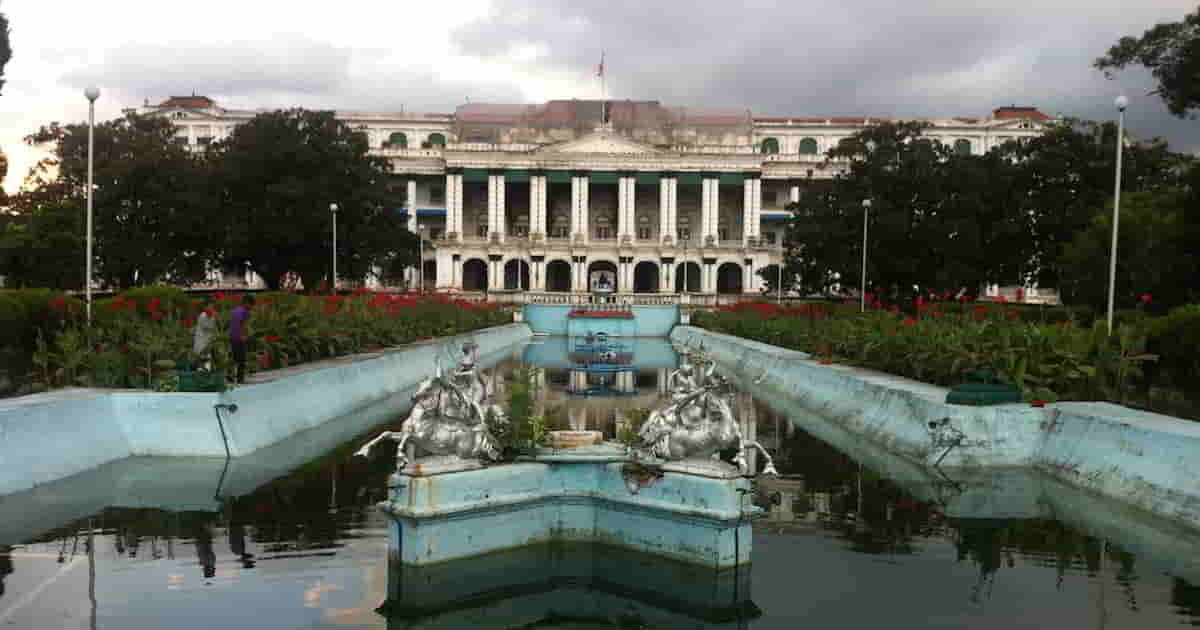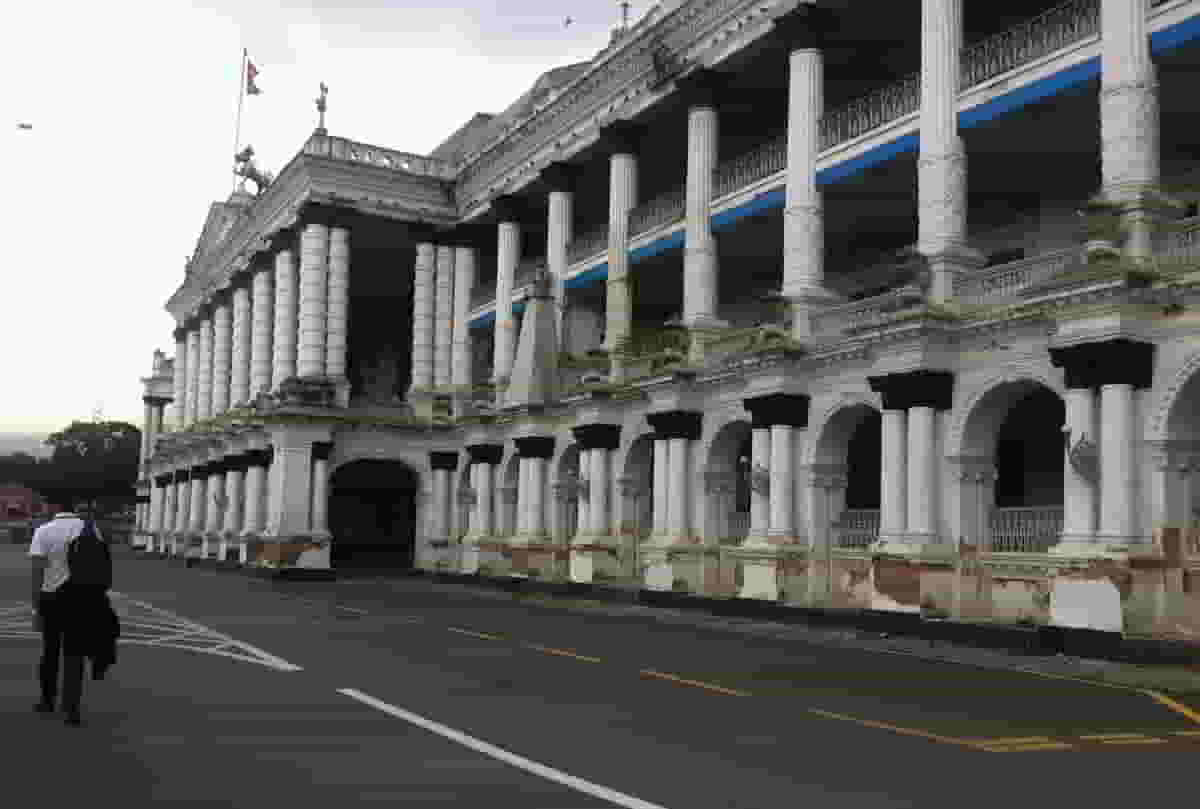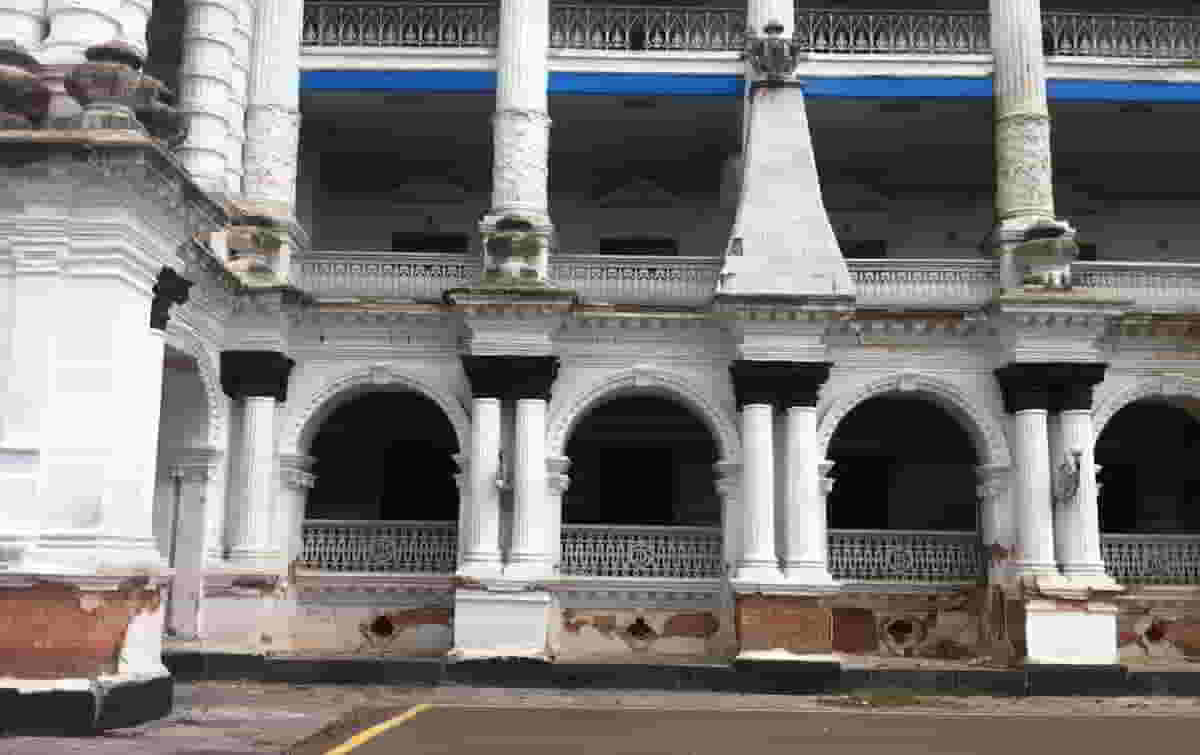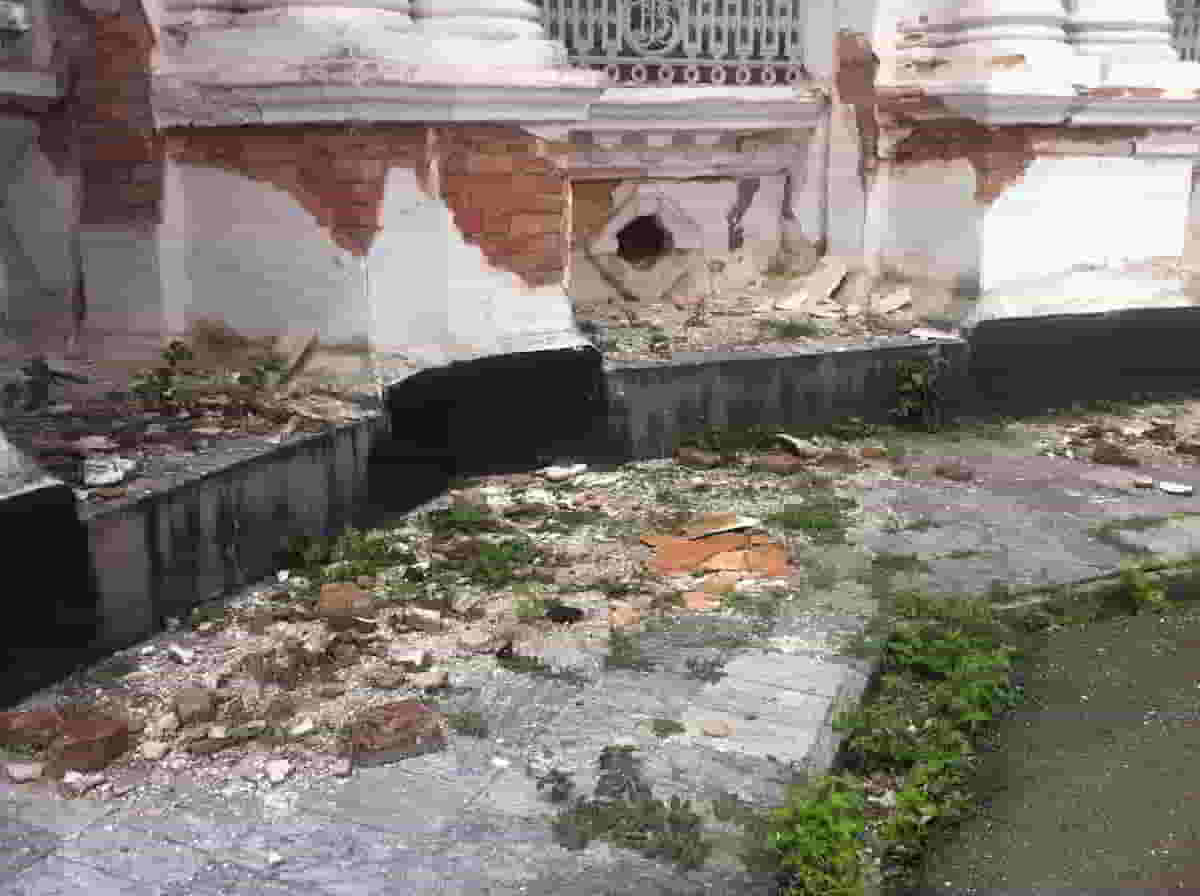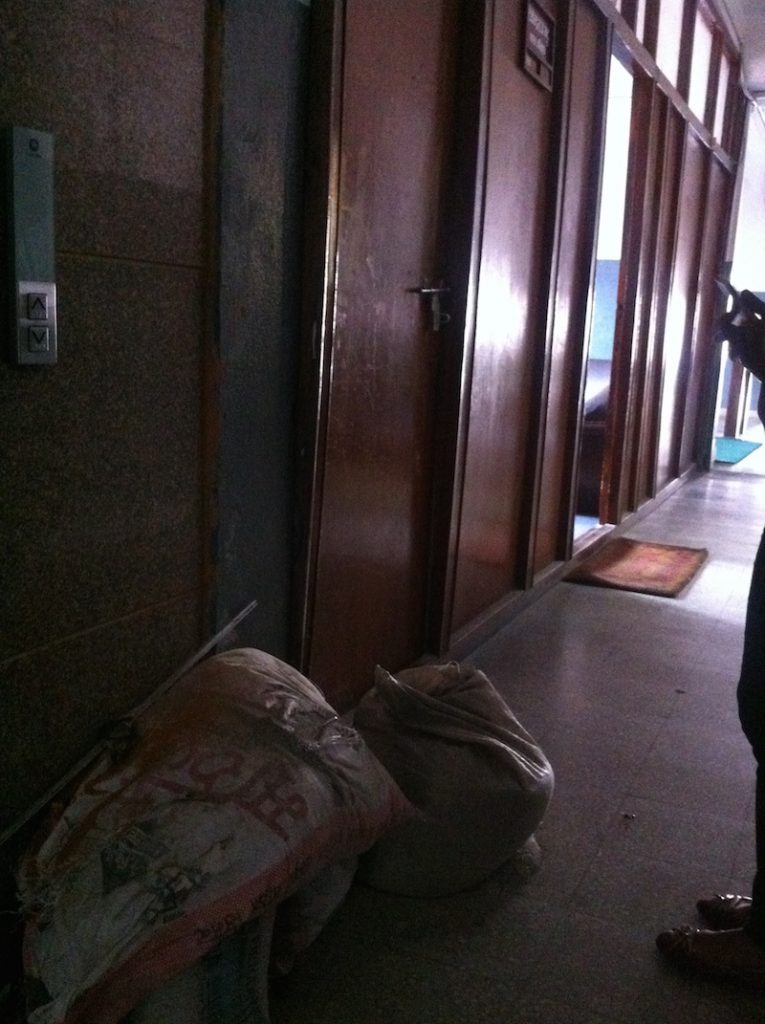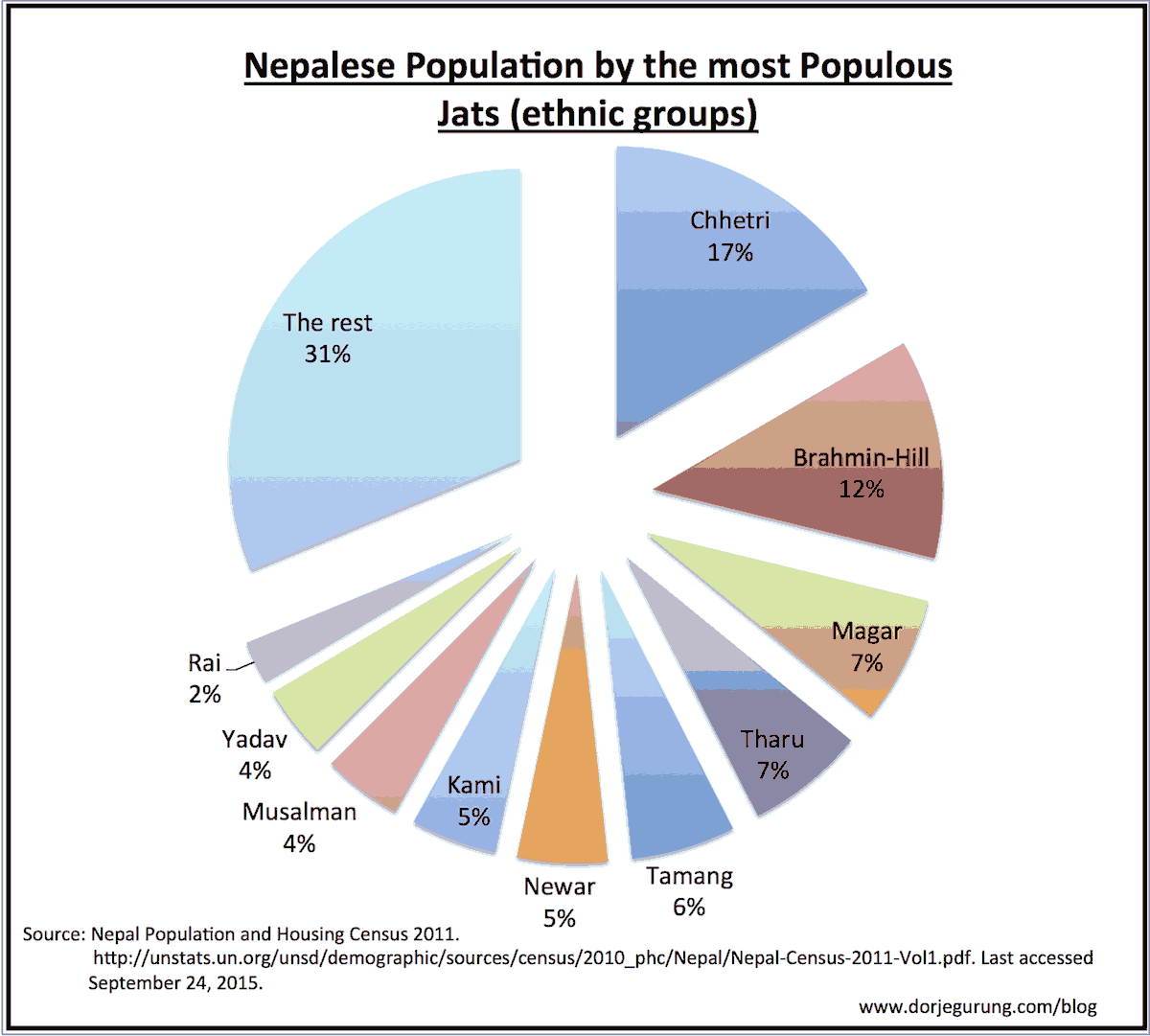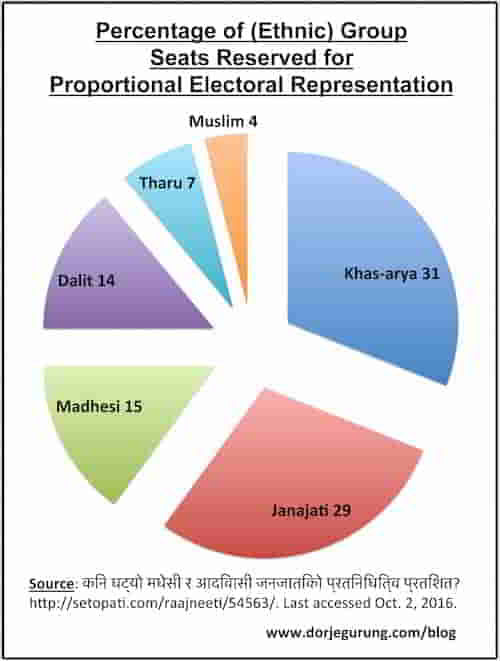In rural Malawi, cleanliness of the perimeter of the house is a sign of the level of care the woman extends to her home. And so, she cleans and clears the area pretty much every single morning, I was told.
But of course, to some extent, that’s all just a façade! Poor rural Malawian families live in small houses with a single or double or, at most, triple rooms, even while family members number half-a-dozen, for instance. Keeping the interior clean, organized and the children well-looked after, for most rural families, is a difficult proposition. I know because I saw a number of them during my three-year stay in the country.
We in Nepal are also quite big on façades ourselves!
On a September 1 visit to Singha Durbar, the seat of the Government of Nepal, I made two discoveries, one about façade.
The first discovery was that most of those working inside the complex didn’t seemed concerned at all with keeping up façades of any kind.
The second discovery was that both the outside and inside of The Secretariat needed cleaning and fixing— literally and figuratively.
(But before I get into all that, on a side note, I was pleasantly surprised to learn about a change! Unlike how it had been, citizens can now enter The Secretariat at any time during office hours. The last time I visited the place — in February 1999 — ordinary citizens could enter the compound only after 2 pm, unless someone from inside arranged a special permit. Apparently, some activist forced the government to change the rules!)
As for the façade…we in Nepal like to describe our country as “Sundar, shanta, bishal” (beautiful, peaceful, grand) after a patriotic song by — I believe — Gopal Yonzon.
Except, the first thing I noticed, entering the compound, was the state of the façade of the old palace: it was derelict, decrepit and in an embarrassing state of disrepair!
I suspect the reasons are neglect before, as well as damages by, the April and May 2015 earthquake.
To me, it appeared very little effort had been expended in the upkeep of the façade of the old palace and the surrounding area. I understand that the front building is condemned, but that does not preclude cleaning up the area…surely!
Here’s what I am talking about.
Since they haven’t bothered to even clean up the areas surrounding the building, even over the course of more than a year since the quakes, I suspect they have no plans to do anything on, or with, it.
To be sure, there’s more to the neglect than what you can see in those three images.
That, however, is not to say that the government is apathetic towards such structures damaged by the quake. No, no, no! The second government, Oli’s government, wasn’t anyway!
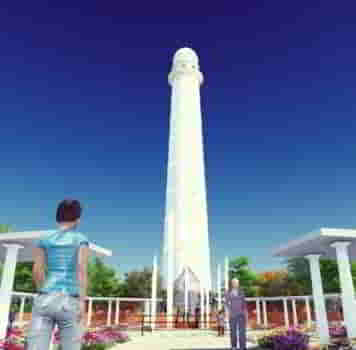
One structure they created a campaign slogan for, mobilized all the ministries and their employees for, developed a detailed “24-point action plan” for, set November 2017 as the construction initiation date for, developed a detailed design for (see image above), kept appealing for support for by no other than Oli, the Prime minister himself and kept getting large sums of donations for (Rs. 1bn from NT, Rs. 10m from NRCL etc.) — is none other than Dharahara.
BUT it’s the biggest — if not the only — phallic structure in Kathmandu! Coincidence? You tell me!
Oli’s government consisted of only 5 women in a 41-body strong cabinet of ministers!
Would a completely different gender-composition of ministers have devoted so much time, energy, effort and money into the re-erection of such a structure with such sense of urgency? Were our society not as chauvinistic as we are, would that Prime Minister and his ministers have chosen to shoot for that?
What used to be referred to as the folly of a man of two centuries ago, promises to symbolize the folly of a collection of 21st century leading (!) Nepalese men! But then, they are a group that have proven themselves to be a bigger disaster than the natural calamity itself, which reduced Dharahara down to its current size, in the first place!
No wonder, those men feel like they have something to prove…and show (or compensate for? 😉 )!
The Secretariat, on the other hand, will continue being neglected.
What of the inside of the structures in the complex?
That they needed fixing, it turns out, even those inside were aware of! Why else would they have piles of cement bags lying around in the corridors?! I came across them in two of the three buildings I visited. Here’s one of them!
And of course, in addition to the structures, I also noticed the people!
We in Nepal, take pride in characterizing ourselves by repeating the words of Prithwi Narayan Shah, the father of our country: “Nepal char jat chhatish barna ko fulbari ho” (Nepal is a multi-lingual, multi-ethnic, multi-cultural garden). We are indeed an incredibly diverse population.
Here’s how the population breaks down by ethnicity according to the National Population and Housing Census 2011.
According to the same census report, a little over fifty percent of those are women.
Furthermore, apart from the Chhetri and the Hill Brahmins — for whom the mother tongue is Khas Kura, the lingua franca of the country and commonly referred to as Nepali — most other ethnic groups have their own language and culture.
But — and this is the first thing I noticed about the people — the compound was filled mostly with MEN!
Of the people I saw or came across — whether milling around outside, or heading to some ministry, or inside the few buildings I myself visited — only one of six must have been a woman! In one room, we saw what looked like a meeting attended by over a dozen people. Every single one of them was a MAN!
The second thing I noticed was the names of the office bearers in different ministries.
Lack of women representation in the compound and inside those offices weren’t the only inclusion issue. We have always known about that. Click here for a September 6 article published on OnlineKhabar about how we have NO female Secretaries. I have also blogged about it. Click here for a blog post about lack of women representation.
I have also known about the lack of ethnic diversity in a number of different government and professional bodies about which I blogged here. But the data I analyzed in my blogs did NOT include Ministries.
To begin with, the current cabinet of ministers, not unlike the last two since the promulgation of the constitution a year ago, aren’t very diverse.
Minister = Mister in #Nepal, like all high ranking positions. (Another one for my #HallOfShame.) pic.twitter.com/NfLT2uIuyF
— Dorje Gurung (@Dorje_sDooing) August 27, 2016
(If you are interested, you can find the names of all the ministers we have had from 2007 (1951) to 2064 (2007) here.)
Apparently, “women, Madhesis, indigenous people, Dalits and other backward communities in recent cabinets has been constantly on the decline with the formation of each new government since 2007” according to this article in My Republica.
The office bearers…well…were no different in their lack of diversity either. Here, for example, are the names of the Ministry of Education office bearers.
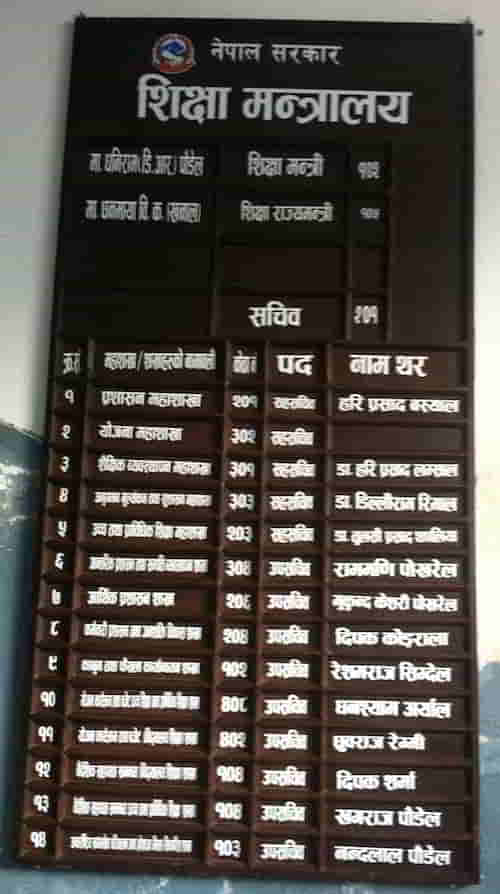 | 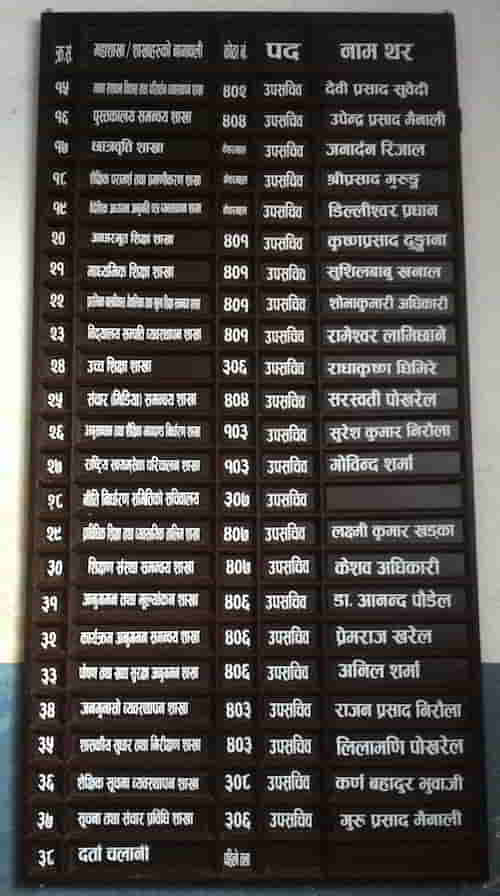 |
| Click on the image for the original and have a read of the names. What do you notice about their gender and ethnicity? (Click here for the online version of the same information.) |
Two other ministries we visited were the Ministry of Population and Environment and the Ministry of Physical Infrastructure and Transportation.
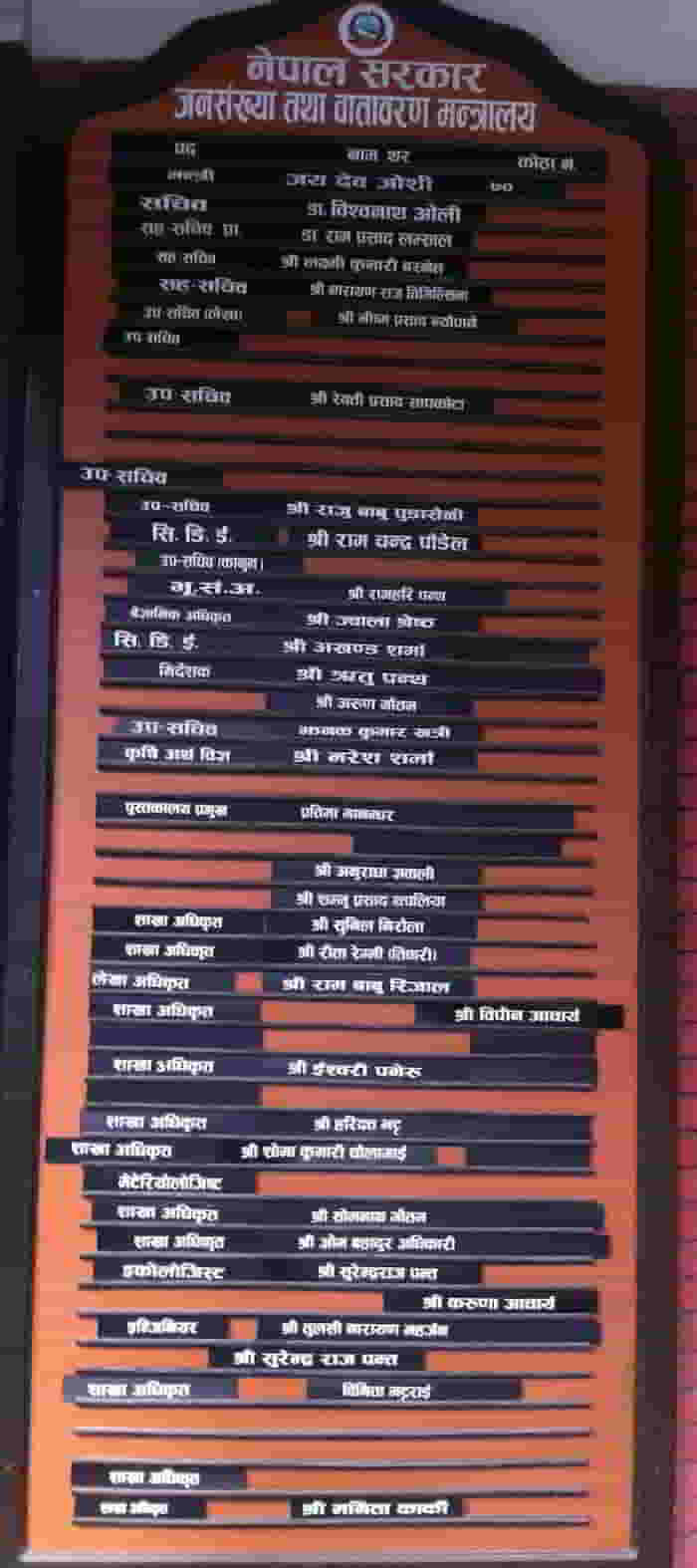 | 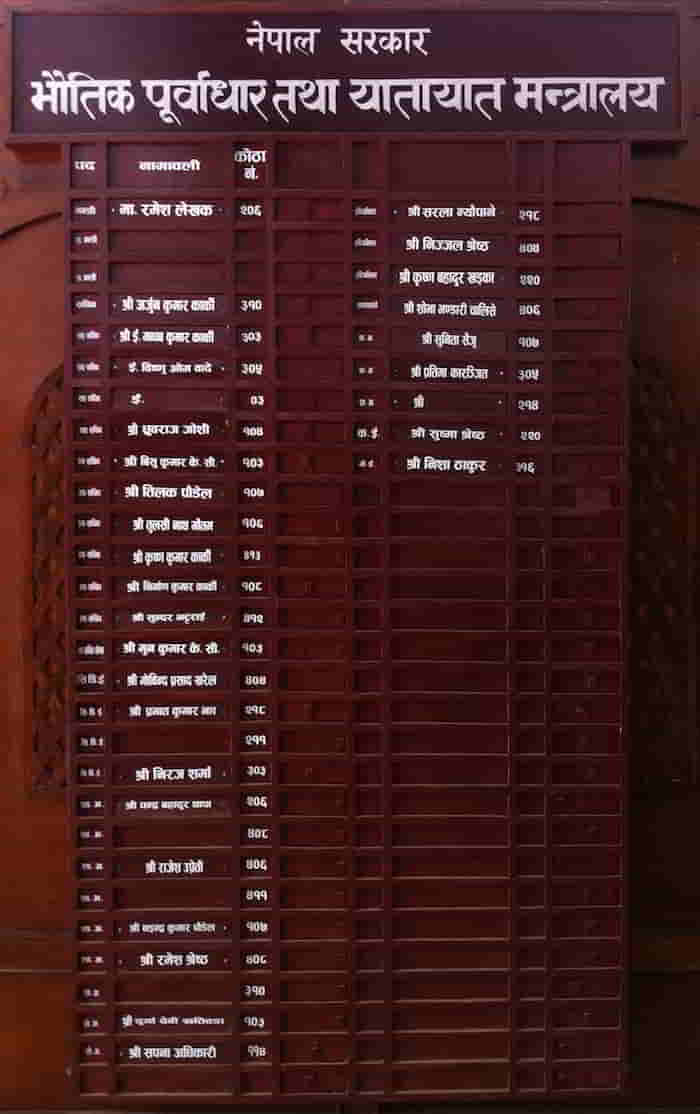 |
| Click on the image for the original. Anything about the names that jump out at you? (Click here for the online version.) | Click on the image for the original. What about these names? (Click here for the online version.) |
Office bearers at other ministries, a number of which I also photographed, showed these three to be typical.
Incidentally, if you are interested, the information is available online. All you have to do is go to the Council of Ministers page and follow the link to the homepage of the ministry of interest. (Not all home pages list their office bearers though.)
To save you the trouble, I have reproduced links to several of them.
- Ministry of Finance Staff List
- Ministry of Energy Personel
- Ministry of Defence Staff Profile
- Ministry of Supplies Who is Who
- Ministry of Labor and Employment Staff
- Ministry of Agriculture Development Staff
- Ministry of Youth and Sports Staff List
- Ministry of Land Reform and Management Staff List
Did you follow some of those links? Did you have a read of the names? What did you notice?
If you did, you would have noticed that, firstly, they are mostly men, and secondly, the Khas-aryas (Brahmins and Chhetris) are disproportionately represented in pretty much every ministry.
As if what I saw wasn’t enough, on the same day I visited the compound, this Nepali article came out.
The article contends that two dozen “powerful” civil servants in Singha Durbar have been drawing salaries for years without ever even showing up for work.
And those were probably only the ones they found out about. How many more must there be that we’ll never know or hear about?
Did I say the place needs cleaning?! If you ask me, it need purging!
Our constitution calls for, and those entrusted with implementing its dictates, at least in public, endorse inclusive democracy and everything else that implies and entails, proportional representation being one of them.
According this article in Setopati, the following is the most recently worked out percentages for different groups to ensure proportional representation. This, incidentally, is a slight revision of the percentages inked in the 2007 interim constitution.
Female representation is supposed to be at 33%. We did NOT see that kind of representation whether in the 2008 nor in the 2013 Constituent Assembly nor in appointments made since the promulgation of the constitution, such as the National Reconstruction Authority.
For sure, making the government more diverse is one change that will help the country considerably in its quest to develop economically, socially and politically.
And for sure as well that implementation of the constitution takes time blah blah blah….
But if the identities of those in positions of power in the rooms and corridors of The Secretariat (and elsewhere) are any indication, the powers be are just all about creating and maintaining a façade of inclusiveness and democracy in writing (the constitution) and speech (what they say to the public) to placate the population, while they are actively undermining all the principles enshrined in the constitution and even sabotaging it at times.
But know this! Both the inside and outside of the physical structures in the once grand complex, and those who work within, on our behalf, need some cleaning, some purging, and some fixing.
We must move beyond creating and maintaining the facade that we have our house in order, the way rural Malawi women do with their morning cleaning rituals around their homes.
Those Malawian women probably don’t feel they have a choice. We, on the other hand, do!
Sept. 30, 2018 Update
Here’s what Dharahara looks like now, the reconstruction of which was supposed to have started back in November 2017! The photo was taken yesterday. Clearly, no work has been done.
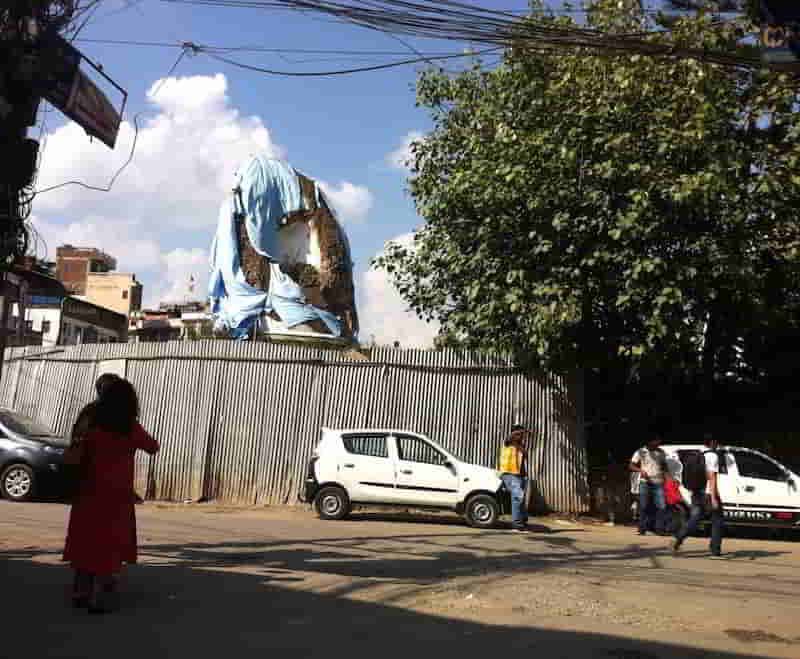
In contrast, Baudhanath Stupa has been reconstructed completely! The reason may have to do with the fact that those involved in it’s reconstruction was the locals and NOT the government of the country.
December 28, 2018 Update
According to this article in The Kathmandu Post, the Prime Minister, KP Oli — yes, the one who started the “I Will Build My Darahara” campaign in 2016 — laid the foundation for the reconstruction of the structure yesterday! What happened to that campaign and plan of beginning the reconstruction in November 2017? The article had this to say:
“On February 2016, Oli had announced the campaign ‘I will build Dharahara’ with an aim to collect funds for the reconstruction of the historic monument.
He had even chipped in his one-month’s salary in the citizen’s fund. The earlier campaign, which had collected Rs 2.4 million funds, was aborted due to unspecified reasons.”
What happened to the funds collected then? The article does NOT say.
April 23 Update
Didn't read article but what tweet says is cherry on d cake as it were! 😉
— Dorje Gurung, ScD (h.c.) (@Dorje_sDooing) April 22, 2021
THE reason a pretty much all-male decision makers prioritized d reconstruction of Dharahara was b/c it's a #PhallicSymbol.
Topping it with #ShivaLinga, they have acknowledged it & consecrated it! 😉 LOL! https://t.co/WmSeUuADjU pic.twitter.com/MQIyfegi18
* * * * * * * *
References
These were added after the publication of the post because of their relevance. They are updated continuously.
The Kathmandu Post (Oct. 16, 2018). Brahmins and Chhetris land most government jobs. “Brahmins and Chhetris, two dominant classes in Nepali society, continue to lead in terms of landing civil service jobs despite an inclusive hiring policy reserving quotas for Janajatis, Dalits and other disadvantaged groups.” [Added on Oct. 19, 2018.]
NagarikNews (Nov. 5, 2018). धरहरा पुर्निर्माणमा सहयोग गर्ने प्रतिबद्धता. [Added Nov. 5, 2018.]
LOL! Ppl & orgs pledging to support reconstruction of Darahara. Was supposed to have begun last Nov.!! #Nepal https://t.co/IjMMxyoz6s
— Dorje Gurung (@Dorje_sDooing) November 5, 2018
My Republica (Nov. 5, 2018). Authorities, local communities pledge to help in Dharahara reconstruction. Essentially the above report in English. [Added on Nov. 6, 2018.]
Research Gate (Nov. 2015). The Ain of 1854 and after: Legal pluralism, models of society and ethnicity in Nepal. [Added on Nov. 26, 2018.]
The Kathmandu Post (Dec. 27, 2018). PM Oli lays base for Dharahara amid cultural activists’ protests. [Added on Dec. 28, 2018.]
The Kathmandu Post (Feb. 5, 2019). Structural blindness. “The foundation of modern Nepal lies in the caste system of governance.” “Lower castes faced greater punishments than higher castes for the same crime. for example, in 1940, for protesting against the Ranas, Tanka Prasad Acharya, a Brahmin, was imprisoned; his four friends, charged with same crime, were hanged and shot to death.” [Added Feb. 5, 2019.]
The Kathmandu Post (April 22, 2021). Billions spent on Dharahara but schools reconstruction suffering in lack of funds. They prioritized a phallic symbol over education of children. But then, that’s EXACTLY the sort of thing one would expect from incompetent, insecure, chauvinistic men who feel d need to compensate for their short cumings! 😉 😀 [Added April 23, 2021.]

